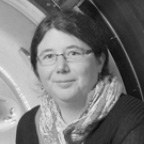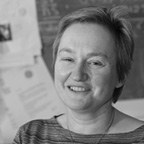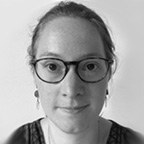Invited speakers abstracts
 Keynote #1 | Stéphanie Roccia | Université Grenoble Alpes, France
Keynote #1 | Stéphanie Roccia | Université Grenoble Alpes, France
Peeping at the Universe through the keyhole
The Universe and its history are at the same time very well understood and a big mystery. We have amazing tools from satellites to observatories to weight the universe as it is today and also as it was in the past. But the content of the Universe can simply not be explained by physicists.
To get the full picture, we need to identify and understand the interactions at play throughout the life of the Universe. This is the meeting point between the infinitely small, the study of interactions with particles, and the infinitely big, the cosmology.
I will guide you at this meeting point where the neutron, a very common neutral particle that is one of the main components of the human body, is used as a tool to understand why and when the matter prevailed over anti-matter. We are also starting to use it to probe extra-dimensions in the Universe … an idea that came from Namur.
 Keynote #2 | Cynthia Liem | TU Delft, the Netherlands
Keynote #2 | Cynthia Liem | TU Delft, the Netherlands
On relevance and responsibility - from piano to policy
In this talk, I will present how my dual background in music and computing led to an unusual career trajectory. I will discuss how common assumptions and success criteria in the design of search engines and recommender systems were not compatible with my interests and needs as an artist, leading to my research interests in validation and validity of data-driven systems, and ways to still keep 'that what is not obvious' within reach in a world of digital information overload. Furthermore, I will highlight the importance of being able to communicate across disciplines, which has not only benefited me when working with artists and scholars in the humanities, but also in collaborations with social science researchers, and in matters of academic and tech policy.
Throughout the talk, I will touch upon more fundamental questions on what it means to 'have relevance'. While my take on this question has not been in line with traditional perspectives on the academic career, I will argue it is in line with values that academia upholds, and aligns well to increasing demands for transdisciplinary and public-interest research and education.
Cynthia Liem on the TU DELFT website...
 Talk #1 | Céline Noël | IMEC, Belgium
Talk #1 | Céline Noël | IMEC, Belgium
Oil as an enabler for nanotomography analyses
The ever-increasing complexity of semiconductor devices and the pervasive introduction of three-dimensional (3D) architectures require innovative three-dimensional materials characterization techniques for confined volumes.
To meet this demand, multiple atomic force microscopy (AFM)-based methodologies, using a slice-and-measure approach, often referred to as scalpel scanning probe microscopy (SPM) have been proposed to visualize tomographic information in confined volumes in a wide range of devices and bulk materials. They consist of scanning AFM probes that erode locally the sample’s material at a relatively high load while sensing with the secondary AFM channel, thus accessing in-depth information compared to the standard surface-limited analysis.
Nonetheless, an overlooked aspect of scalpel SPM is the heavy debris accumulation at the tip apex and inside/around the scan area. As the high-pressure scan is performed, the etched particles pile up, coalesce, and eventually reattach to the surface. This is directly affecting the measurement quality and repeatability, contributing to the tip wear, and limiting the maximum 3D scan depth. These are the main reasons for the limited usability of scalpel SPM.
It is well known from the macroscopic and nanoscopic machining world that cutting fluids such as oils can significantly improve the cutting tool's lifetime and flush away debris from the cutting area. Here we explore the use of oil as a suitable medium to overcome the issue of scan debris accumulation while preserving the precise removal rate capability, and electrical AFM modes functionality.
Céline Noël on the UNamur research portal...
 Talk #2 | Alice Dennis | UNamur, Belgium
Talk #2 | Alice Dennis | UNamur, Belgium
My research focuses on the evolution of adaptive traits. I am fascinated by the abilities of some organisms to survive in extreme and novel conditions, such as freezing temperatures.
To understand this, I integrate physiological and molecular experiments with field work. I use physiological tests to understand survival of harsh conditions or how plasticity allows some species to better survive. I couple this with transcriptomic and genomic studies to identify the genes that have evolved to give greater adaptive abilities.
By comparing close relatives, I try to understand how they have evolved in relation to past and present geographic ranges. I study not just freeze tolerance, but also greater tolerance of heat, pollution, and changes in diet.
Today I will talk about two systems where I have used freeze tolerance to better understand where species live: intertidal snails in the USA and stick insects in New Zealand.
Alice Dennis on the UNamur research portal...
 Talk #3 | Anne Lemaître | UNamur, Belgium
Talk #3 | Anne Lemaître | UNamur, Belgium
Celestial mechanics and mathematical tools for space debris
Six decades of space activities have led to a congested near-Earth environment, analogous to the 7-th continent of plastic waste in Earth's ocean. The space debris, uncontrolled remnants and hazards linked to human space activities, have dramatically increased in number over the years and some of them have « life expectancy » of thousands of years.
They clearly behave as natural bodies, and no more as controlled artificial satellites.
Three tools of celestial mechanics, traditionally developped for asteroids or particles in rings, were successfully adapted to space debris: symplectic integrations, resonances and chaos measurements, creating a first bridge of collaborations between two scientific communities. Moreover thanks to the creation of the research institute naXys, a second interdisciplinary bridge was developped with mathematicians: as results, the population of space debris has first been treated as a synthetic population, allowing simulations and predictions, and is now modelled on a dynamical network, with the links connected to the probability of collision.
Anne Lemaître on the UNamur research portal...
 Talk #4 | Katy Poncin | UNamur, Belgium
Talk #4 | Katy Poncin | UNamur, Belgium
A serendipitous discovery – How some bacterial pathogens kill themselves, and why it matters
Neisseria gonorrhoeae is the bacterium responsible for the sexually transmissible disease gonorrhea. It is exquisitely adapted to its human host and long-lasting immunity cannot be achieved, either naturally or through vaccines. Fortunately, there exist ways to study it in vitro, on petri dishes and in liquid media.
In their natural environment, bacteria have to compete against each other for resources, including space and food. To do so, they are equipped with different tools, such as harpoon-like apparatus and toxins. While looking for putative toxins that are only present in the genome of pathogenic Neisseria species, we found conserved cationic peptides of unknown function. Surprisingly, we realized that our hypothesis was wrong and that the peptides were instead involved in a suicide process called autolysis. Moreover, we found that the peptides have a direct effect on humans, by destroying red blood cells and playing on inflammation factors.
During this talk, I will therefore share with you the story of how this unexpected discovery was made.
Katy Poncin on the UNamur research portal...
 Talk #5 | Katrien Beuls | UNamur, Belgium
Talk #5 | Katrien Beuls | UNamur, Belgium
Building machines that learn and use language in a similar way than we do
As human beings, we acquire our native languages by taking part in communicative interactions that are meaningful in the environment in which we grow up.
On a fundamental level, there are two main cognitive mechanisms at play during language acquisition: intention reading and pattern finding. Intention reading refers to the capacity to hypothesise about the intended meaning of an observed utterance based on the situational context it is uttered in. Pattern finding refers to the ability to generalise over pairs of observed utterances and their hypothesised meaning, yielding form‐meaning mappings of varying degrees of abstraction. The mechanisms through which humans acquire language are in sharp contrast with the methodologies that currently dominate the field of natural language processing (NLP). Indeed, unlike the linguistic systems of humans, large language models are learnt with an exclusive focus on linguistic forms (characters, words and sentences), in the absence of meaningful and intentional communicative interactions that take place in situated environments.
In this talk, I will discuss recent advances in modelling language acquisition in a more human-like manner, and show how we can operationalise the processes of intention reading and pattern finding in artificial agents.
 Talk #6 | Hélène De Longueville | ULB, Belgium
Talk #6 | Hélène De Longueville | ULB, Belgium
Atmospheric trends of halocarbons derived from 15 years of IASI space observations
The chemical and radiative equilibrium of our atmosphere has been profoundly modified by the emissions of halocarbons, among which chlorofluorocarbons (CFCs), their hydrogenated derivatives (HCFCs, HFCs) and halons. These halogenated compounds are known to be powerful greenhouse gases and contribute, for chlorinated and brominated compounds, to the depletion of stratospheric ozone and to the development of the ozone hole. Therefore, the production of many of these anthropogenic gases is controlled since 1987 by the Montreal Protocol and its amendments. A continuous monitoring of CFCs and related halogenated substances is essential to evaluate the effectiveness of international regulations. Here we exploit measurements from the infrared satellite sounder IASI which offers the potential to robustly assess trends in the atmospheric abundances of trace gases owing to the stability and the consistency of the measurements made by three successive instruments over a period of more than 15 years.
Despite their weak spectral signatures, we have recently reported the detection of eight long-lived halocarbons in IASI spectra: CFC-11, CFC-12, HCFC-22, HCFC-142b, HFC-134a, CF4, SF6 and CCl4. In this work we exploit the available record of continuous IASI measurements to determine the temporal evolution in atmospheric abundance of these species. Our results are validated with ground-based measurement networks and other remote sensors data. We conclude by assessing the usefulness of IASI and follow-on missions to contribute to the global monitoring of CFCs and their substitutes.
Hélène De Longueville on Squares ULB...